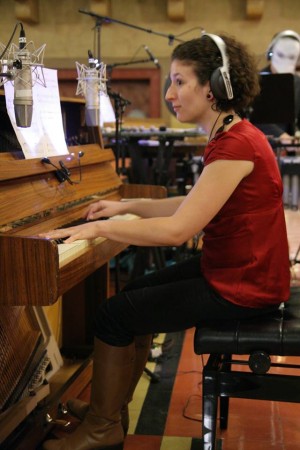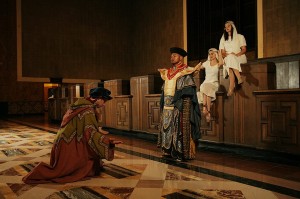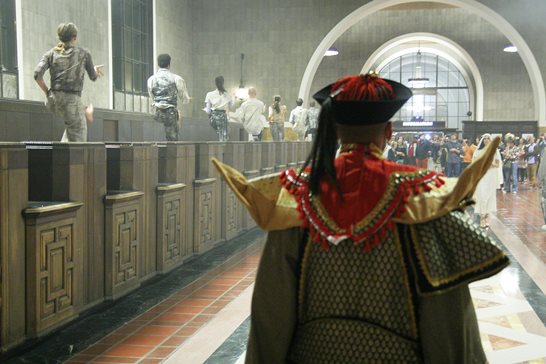The overture ended, a set of heavy double doors opened, and into Union Station spilled the opera audience. As the group dispersed, some displayed trepidation in their quest for the singers heard in their headsets. Others eschewed the life-sized version of Where’s Waldo: One couple made a beeline for the bar; ordering a bottle of wine, they watched and listened from a comfortable perch.
 There is no right or wrong way to experience the opera Invisible Cities, Yuval Sharon assured the audience in his pre-show speech. The audience can expect to stumble upon some scenes and miss others, he said. Sharon is the artistic director of The Industry, the fledgling company that produced the site-specific performance of Christopher Cerrone’s opera, which is performed amongst the denizens of Union Station—commuters, employees, and transients alike.
There is no right or wrong way to experience the opera Invisible Cities, Yuval Sharon assured the audience in his pre-show speech. The audience can expect to stumble upon some scenes and miss others, he said. Sharon is the artistic director of The Industry, the fledgling company that produced the site-specific performance of Christopher Cerrone’s opera, which is performed amongst the denizens of Union Station—commuters, employees, and transients alike.
 Whereas traditional opera relies on the power of raw auditory stimulation, Invisible Cities is entirely mediated. The audience is equipped with headsets. Singers and orchestra members are mic’ed and broadcast through them.
Whereas traditional opera relies on the power of raw auditory stimulation, Invisible Cities is entirely mediated. The audience is equipped with headsets. Singers and orchestra members are mic’ed and broadcast through them.
Conductor Marc Lowenstein and his 11-piece orchestra are confined to a room outfitted with the necessary high-tech sound equipment. Sennheiser USA, one of the Invisible Cities sponsors, provides the state-of-the-art technology.
A cast of LA-based singers, led by Cedric Berry and Ashley Faatoalia, delivered Cerrone’s tight harmonies and sustained lines with graceful intensity. Impressively, they demonstrated the required restraint for mic’ed singing.
Choreographer Danielle Agami made good use of the station’s architecture, deftly weaving eight dancers from L.A. Dance Project in and around the space … and its spectators.
Cerrone’s composition masterfully mixes tonalities from East and West in keeping with the opera’s imagined meeting between Kublai Khan and Marco Polo. The libretto, also by Cerrone, is based on an Italo Calvino novel. Possessing the intimacy and urgency of a whisper, it’s the score that unifies the otherwise aimless theatrical experience. Headsets emphasize Cerrone’s orchestration, which creates a mystical and meditative ambiance against the backdrop of a busy train station.
 In the opera, Polo contemplates the distant extremes of the empire. Without knowing many of the cities and people he rules, he instead describes to Khan imaginary cities with mystical qualities.
In the opera, Polo contemplates the distant extremes of the empire. Without knowing many of the cities and people he rules, he instead describes to Khan imaginary cities with mystical qualities.
“Invisible Cities”‘s epilogue has the cast converging in the station’s historic ticketing room. The audience reunites there as well. Berry oversees the proceedings at the end of the long room, resplendently dressed as Kublai Khan. The rest of the cast, dressed as spectral travelers, carry valises. The entire effect is like a fantasy travelogue.
I removed my headset to hear the vocal harmonies reverberate live throughout the cavernous space. Relieved of the headset, I indulged in an unmediated musical experience that provided a moving closure to the performance.
The Invisible Cities experience is layered. It’s intensely personal and uncomfortably voyeuristic. It dissolves the thin veil between reality and artifice. The headphones function as a Mardi Gras mask, granting the audience permission to act more boldly in an environment that otherwise promotes anonymity. The audience’s proximity to the performers and the interactions with the station’s non-opera inhabitants serve as stark contrast to the passive role relegated to audiences in traditional theater.
As audiences for classical music dwindle nationally, producers are turning to alternative formats to reach an elusive new audience. Site-specific performances are one popular format. Companies such as New York’s Elevator Repair Service and London’s Punchdrunk are significant international players. Similarly, in Los Angeles, choreographer Heidi Duckler has led audiences through abandoned buildings, parking garages and laundromats for two decades.
Beyond its theatrical inventiveness, The Industry is committed to producing the work of contemporary composers. The company’s first undertaking in 2012 was Crescent City, Anne LeBaron’s composition performed among art installations in an Atwater Village warehouse. Since then, the company shows signs of evolving sophistication. The successful staging of Cerrone’s opera in a train station signals a promising future for The Industry, and the sold-out run confirms that the Los Angeles audience has a keen appetite for adventurous art.
Photos by Dana Ross
Guest writer Thor Steingraber is a Los Angeles-based arts producer, educator, and writer. He tweets at @tsteingraber.


Very nice review. That is the best description of the Opera’s story-line that I have read and a good depiction of the audience experience. Beautiful use of those gorgeous photos too, I might add.